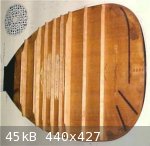jdowning
Oud Junkie
    
Posts: 3485
Registered: 8-2-2006
Location: Ontario, Canada
Member Is Offline
Mood: No Mood
|
|
Below Bridge Bars - a Missing Link?
In January 1994 I wrote a preliminary research paper about early lute barring, published in FoMRHI (Fellowship of Makers and Restorers of Historical
Instruments, Quarterly #74).
Since writing that paper, I now have confirmed (thanks to this Forum) that a standard barring feature for ouds of today is to include a brace between
the bridge and bottom of the soundboard - a feature that does not appear in surviving lutes of the 16th C and 17th C to my knowledge. As the oud is
supposed to be the direct ancestor of the lute in Europe, I speculated that at one time the lute also may have had a similar below bridge barring
arrangement. As there has been some recent discussion about barring arrangements in this forum I thought that I would post the above article for the
information of members interested in the history of the oud and lute.
I also look again at the now familiar Arnault de Zwolle lute geometry from a different perspective where, by elimination of the massive bottom block,
the barring layout then approaches that of lute barring of the 16/17 C as well as that of modern ouds.
All of this is still speculation but recent postings of oud bracing geometries on this forum has helped to add a few more data points to the general
historical overview.
I first came to the forum as a 'hands on'researcher in the field of early stringed instruments (I make reconstructions of early instruments for my own
use and to test out theories about their construction etc). I was at the time full of optimism that I would find preserved, examples of ouds dating
back to the
16th C or earlier that might provide information that is otherwise missing from a study of surviving lutes. I was, therefore, astonished (and somewhat
dismayed) to discover that, apparently, no examples of early ouds survive - nothing prior to the 19th C - making research into the early oud even more
difficult than it is for the lute.
The general assumption, of course, is that due to the close similarities between the construction of lutes and ouds that the oud directly influenced
the development of the lute historically - as I have taken for granted in the above paper. However, as there are no existing ouds made prior to the
19th C we do not know if - by the 15th C in Europe for example - it might have been developments of the lute that had some influence on the evolution
of bracing of the modern oud? Just some food for thought!
Attachment: FoMRHI Comm 1237 default.pdf (439kB)
This file has been downloaded 530 times
|
|
|
oudmaker
Oud Junkie
    
Posts: 220
Registered: 12-23-2004
Location: Philadelphia-USA
Member Is Offline
Mood: No Mood
|
|
Jdowning
I use your #2 bracing system. Only make sure third bracing will be much shallower than others Its called DUGAH bracing among the oldtimers.
Regards
Dincer
|
|
|
jdowning
Oud Junkie
    
Posts: 3485
Registered: 8-2-2006
Location: Ontario, Canada
Member Is Offline
Mood: No Mood
|
|
Thank you Dincer. The #2 bracing system is that of an Egyptian oud that I am restoring. All of the bars are, more or less, equal in height measuring
around 16mm.
This equal bar height also seems to be a general feature of early 16th C lutes as well at early 18th C lutes (possibly because the 18th C luthiers of
the Baroque period copied the geometry of the early 16th C lutes).
By way of comparison, surviving lutes of the late 16th/17th C generally have unequal bar heights. The two main bars - on each side of the rose - being
the deepest, followed by the bar (or bars) above the rose which are about 75% of the height of the main bars and the two bars between the bridge and
rose being about 50% of the height of the main bars. Structurally, therefore, these lutes were rigidly braced across the rose and quite heavily braced
above the rose but more lightly supported between bridge and rose.
The attached image of a scrap lute soundboard, from a copy of a 16th C lute, shows the above barring arrangement (ignore the inked areas which are
there just to show the area of the neck block and demonstrate typical below bridge fan bracing). This soundboard - which had no below bridge bracing -
was found to be unsatisfactory and was later replaced with a new soundboard having a single below bridge bar - like an oud - as an experiment. This
change made a significant improvement to the response, volume and sound balance of the lute.
Are there other traditional bracing arrangements for (Turkish?) ouds apart from the DUGAH?

|
|
|
|